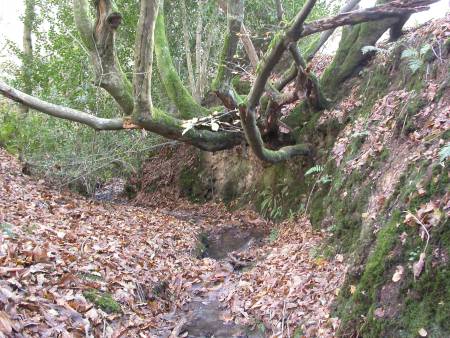There are some good little corners in the north-eastern part of Hartfield parish. With just one remaining square in my local patch that needed a visit I was eyeing up possible good locations, and alighted on a bit of ancient woodland called Coomb Wood. Sounds promising, and the contours were reasonably close together so even though I only had a few hours at most, it seemed like a good place to target, and there was also somewhere convenient to park on the B2026 just by the junction.
The footpath took a course towards the south-west across an arable field with loads of Tortula truncata, Barbula unguiculata and Dicranella staphylina, and cut the corner of Broomland Wood. The wood didn’t produce any surprises but at least added another 15 species in about ten minutes. A few more common plants dotted the footpath as I headed south and finally got to Coomb Wood. It certainly looked that it might be worth exploring; a nice little Wealden ghyll stream, running down into the Medway. Pausing to check out an old stump I noticed a small rock at its base in a damp shady hollow. A quick scrape followed by somewhat longer at home with the microscope revealed it was home to Fissidens pusillus and a tiny amount of Dichodontium pellucidum.

Dichodontium pellucidum
Finally in the shelter of the valley and away from the icy wind it was rather delightful working my way down stream, where Chiloscyphus polyanthos was fairly common, and a clump of Plagiochila porelloides perched by the side of the water.

A mat of Chiloscyphus polyanthos in the stream
There was a good quantity of Ash in the wood, which helped add to the species list, and the base of one tree by the stream had a sizeable mat of Thamnobryum alopecurum. One of the rocks in the stream had a coating of Conocephalum conicum, and Plagiothecium denticulatum was on the branches of one of the trees overhanging the water.

The tree with Plagiothecium denticulatum
By now getting rather cold I was ready to turn back, noticing Pogonatum aloides on the soil on an upturned tree base, as well as a little bit of Dicranum scoparium on a log, and Orthodontium lineare covering the side of a fallen tree.
In the end, two and a half hours had yielded 53 species, and there are still lots of common plants that I didn’t find. I wouldn’t be surprised if TQ43U harbours 70 or 80, and will return in the New Year.
Advertisements Share this:




